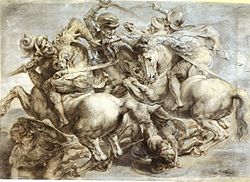Niccolò Piccinino facts for kids
Niccolò Piccinino (born in 1386 – died on October 15, 1444) was a famous Italian condottiero. A condottiero was a leader of a group of soldiers (mercenaries) who fought for different cities or rulers in Italy during the Middle Ages and Renaissance.
Contents
Early Life and Beginnings
Niccolò Piccinino was born in Perugia, a city in Italy. His family owned a house and a butcher shop, so they were part of the middle class. Even though some people later called him "son of a butcher" to insult him, his family was well-known.
He started his military career working for Braccio da Montone. Braccio was another powerful condottiero who was fighting against Perugia. After Braccio died, Piccinino took over his group of soldiers.
Fighting for Milan
After a short time working for the city of Florence, Piccinino joined Filippo Maria Visconti, the Duke of Milan, in 1425. He fought alongside another condottiero, Niccolò Fortebraccio. They fought in the Wars in Lombardy against a group of powerful states, including the Pope, Venice, and Florence.
Piccinino won an important battle against the Venetians at Delebio in 1432. He also defeated the Pope's army in 1434. When Fortebraccio was defeated and killed, Piccinino became the main leader of the Milanese army. He then took control of several cities in a region called Romagna through clever tactics.
Key Battles and Challenges

In 1438, during another war between Venice and Milan, Piccinino tried to capture the city of Brescia. However, another condottiero named Scaramuccia da Forlì, fighting for Venice, stopped him.
In 1439, Piccinino continued to fight in Lombardy. He had mixed results against Francesco Sforza, who was now fighting for Venice. Piccinino then convinced the Duke of Milan to send him to Umbria. He hoped to create his own small kingdom there, just like many other condottieri tried to do.
He was defeated by Sforza at the famous Battle of Anghiari (1440). Interestingly, many of his captured soldiers were quickly set free, which was common in wars fought by these mercenary armies.
Later Years and Legacy
The war then moved back to Lombardy. Piccinino managed to defeat and surround Sforza at Martinengo. He asked the Duke of Milan for control of the city of Piacenza as a reward for capturing Sforza.
However, the Duke of Milan made a truce with Sforza instead. Sforza was becoming very powerful, which worried the Pope, the King of Naples, and even the Duke of Milan. They gave command of their combined forces to Piccinino.
Piccinino managed to push Sforza out of a region called the Marche. But Sforza later defeated Piccinino at Montelauro. While Piccinino was getting ready for another big fight against Sforza, he was suddenly called back to Milan. His army was defeated while he was away. He died in 1444 from sadness and his injuries.
Piccinino was a short man and had health problems, but he was very brave. He was also very clever and never gave up easily, even after defeats. He was known for being cunning and sometimes tricky. His main goal was to gain more power and land for himself.
Niccolò Piccinino had two sons, Jacopo and Francesco, who also became condottieri.
See also
 In Spanish: Niccolò Piccinino para niños
In Spanish: Niccolò Piccinino para niños


